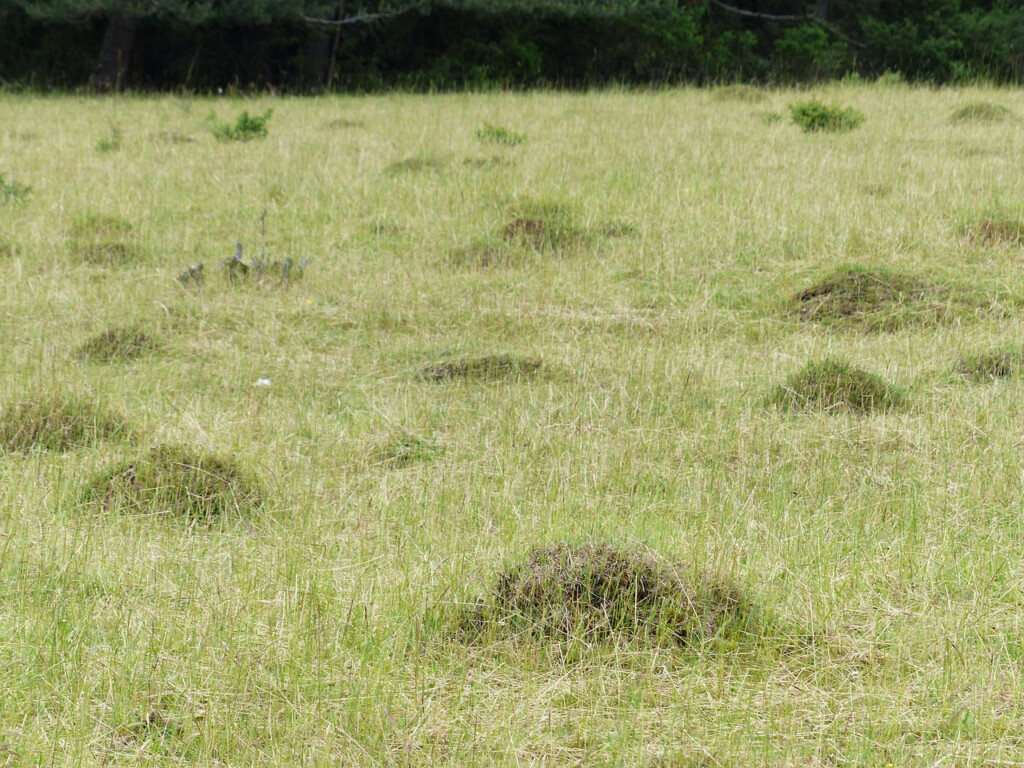
Q: I have an ant problem in my yard – they even steal my grass seed, and they make hills all over – what can I do? I have pets and kids so I am wary of harsh insecticides – can I drown them (THE ANTS, NOT THE PETS)?
A: There are various insecticides that will kill ants, but here are some natural ways I picked up on the internet that you may want to try first:
Predators Ground beetles, humpback flies, parasitic wasps, praying mantids and the yellow-shafted flicker all dine on ants. Woodpeckers are voracious ant eaters. You may see them also pick up ants in their beaks and crush them on their feathers. What are they doing this for? Crushing the ants bodies releases tannic acid which in turn protects the bird from parasites!
Here is something interesting: it is said if you take a shovelful of ants from one hill or nest and put it in another ant hill then take a shovelful from that hill and put it where you took the first one the ants will then wage war on one another and do themselves in!
Repellent plants Catnip, pennyroyal, peppermint, sage, and spearmint. Tansy which is often recommended as an ant repellant may only work on sugar type ants. These are the ones that you see on peonies and marching into the kitchen.
Warning: You do not want to plant Tansy anywhere that livestock can feed on it as it is toxic to many animals. Do not let it go to seed either as it may germinate in livestock fields.
Barriers: Sprinkle leaves and flowers from sage, mints or tansy around the outside of your house or plants that are bothered by ants. These plants can also be used as a living barrier for ant control, bearing in mind that they are invasive in their growth habit and using cuttings from these plants as a barrier is more effective. We grow tansy in an out of the way place to harvest the cuttings.
- Vinegar sprays in and around the hose foundation will repel ants. Keep way from the soil and concrete. Lemon juice concentrate can also be used: mix 50/50 with water and spray.
- Ants will not walk through a line of talcum powder or chalk dust. Diatomaceous earth may also be used as a barrier in and out of the household.
- Using a silica areogel/pyrethrum spray applied to the base of plants like eggplants and peppers can control fire ants from girdling the stems and killing the plants. This is a good barrier as it stays “put.”
- Caulk all cracks and crevices in the building to deny them access. Be sure to use high quality pure silicone caulking as these are less likely to shrink or crack once applied.
- Distribute cucumber parings as a repellant. Cucumbers contain a compound known as “trans-2-nonenal” that repels ants as well as cockroaches!
- Try sprinkling some of those instant grits around the nests. See what happens!
- For fire ants: Pour half a cup of Epsom salts into the nest and all around it.
- Sticky barriers like Tanglefoot make an excellent barrier and can be applied to tree trunks to disrupt the ants from farming of aphids. This will naturally biodegrade itself towards the end of the season. NOTE: On young trees with smaller trunks or those with thin bark (aspens, birches etc.) do not apply directly to the bark surface. Instead use some thin fabric tied around the trunk with the sticky stuff applied over this. Remove at the end of the season.
- On smaller plants a bit of petroleum jelly smeared around the base will stop ants immediately.
Direct Controls:
- Pour apple cider vinegar down entrance holes to the nest.
- Using a sugar soaked sponge works well for light invasions of ants. Use a large sponge with big holes in it. Soak it in a strong solution of sugar water and place it where you want to catch the ants. Rinse the sponge out every day in a container of soapy water. Fix it up with the sugar water again and repeat as often as necessary.
- Dust such as Silica Aerogel can last a long time. Their mode of action is to dehydrate the ants. They work slowly and are easy to use in tight areas such as cracks or crevices.
- Make a strong hot water and hot pepper tea. Use the hottest peppers you can find, finely chop them in a food processor, mix with hot water. Pour directly on the nest.
- Douse the nests with boiling water several times. Cruel and can be effective.
- Repeated flooding of the nest every few days using your garden hose can often be enough to get them to relocate. You must be persistent with this method.
- Make teas from tansy, catmint, peppermint or sage to use as repellant sprays for ants.
- Use equal parts of sugar and baking powder. Place around ant infested area and nests.
To make teas:
Take enough cuttings from these plants to tightly pack one 8 ounce cup. Bring 1 quart of water to a boil. Stir in the plants. Take off the heat and allow to cool. Strain this mixture, add 1 teaspoon of castile soap and use as a direct spray. You can also substitute 1 teaspoon of coconut oil soap in place of the castile.
Last Resorts:
Pyrethrum mixed with isopropyl alcohol kills ants on contact. Take 16 ounces of ready to use pyrethrum, mix in 1 tbsp. alcohol. Use this as a drench directly on the active nest.
Boric acid: Mix 1 cup of sugar, 4 teaspoons of boric acid and 24 ounces of water in a glass screw top jar. Shake thoroughly until you can see that all the crystals are dissolved. Now put 1 cup of this mixture into a smaller jar which you have filled halfway with loose cotton. Firmly screw the lid back on, seal around the band with weatherproof tape and using an awl punch a few small holes in the center of the lid. Put this near the entrance of the nest or wherever they have made a path to your house. The key is the ants will get into the jar to eat the sugar and return to the nest and pass it on to the rest of the colony. If you find many dead ants by the jar dilute the solution and try again. With a proper mixture the colony may be destroyed in a few weeks. It does take the destruction of the queen to completely eradicate a colony. Keep this away from kids and pets!
Here is another ant bait recipe:
Mix three parts peanut butter with two parts jelly and add one tablespoon of boric acid per six ounces of mix. Place the bait on pieces of paper so stuff it into large straws and place where you see the ants foraging. Again keep out of the reach of pets and children
Q: What about my new plantings in this cold weather?
A: If you’ve planted any annuals, tender vegetables, perennials or shrubs with tender growth, covering them with an old sheet or a bucket will help protect them from cold damage. If they’re in (movable) pots, bring them into the garage or house to protect them. Be sure to uncover/bring them back out tomorrow. Any established plants will be fine, although you might lose new flowers.
Q: What vegetables/seeds can I start this spring?
A: We carry “cold vegetables” in a 6” pot for $3.99 – these veggies can be planted now, and withstand temperatures down to 25o : Arugula, Asparagus, Beets, Brussels Sprouts, Broccoli, Cabbage, Cauliflower, Collards, Kale, Lettuce , Ming Quin Choi, Pak Choi, Spinach, and Swiss Chard.
Seeds can be planted after the danger of frost, preferably when the soil warms up just enough to keep the seeds from rotting. Every seed packet tells how long it should take for the seeds to germinate. Some gardeners prefer to get a jump on the growing season by planting their seeds indoors in trays and keeping them in bright light until they start to grow. Then when we are past the danger of frost the seedlings can be planted outside, with several weeks of growth beyond what they would have if seeds were planted outside at that point.
Q: Are your seeds organic?
A: Organic gardening means using growing techniques that rely on materials and approaches that are certified organic by the USDA, which is the main regulating body in the United States for organic certification.
They generally use only certified chemicals at the correct dosages. Common organic agriculture chemicals include BT and copper fungicide. These chemicals have been extensively tested and pose less threat to the environment than stronger synthetic chemicals.
It’s important to note, however, that an “organic seed” will not necessarily produce an organic plant. An organic seed will merely produce a seedling that came from organically grown parent plants.
Though our seeds are not certified “organic” (which generally means they have come from organically grown plants), the seeds we sell are non- GMO. [NOTE: In genetic modification (or engineering) of food plants, scientists remove one or more genes from the DNA of another organism, such as a bacterium, virus, or animal, and “recombine” them into the DNA of the plant they want to alter. By adding these new genes, genetic engineers hope the plant will express the traits associated with the genes. ]
Q: Is it safe to plant now? Is it too early to plant?
A: It is safe to plant hardy outdoor trees and shrubs now! Though we may still get periodic dips in the temperature, they should survive without a problem. However, plants with fresh growth can be “tender” and will have their new soft growth damaged by the cold. This will not affect the overall plant survival but the damaged tips may have to be snipped off. If you are planting something with tender growth or have something in your yard that has started growing already, it’s a good idea to monitor the weather and cover your less hardy items for a few cold nights!
Q: Have you gotten many of your shrubs in?
A: We are receiving new shipments daily. What we receive often depends on what the grower feels is ready to ship based on size and quality! This year we are a little behind schedule due to so many weather events in the growing areas.
Q: Can I still prune my crape myrtles?
A: Yes! Late winter (right now) is the best time to prune a crepe myrtle, because it’s leafless and you can easily see all of the branches. It also blooms on new growth, so pruning now won’t reduce blooming. In fact, it may increase it.
Q: What pre-emergent do we have that is safe for pets?
A: We carry corn gluten which would be the safest pre-emergent for both kids and pets. Corn Gluten is an all-natural by-product of the production of corn starch, and works by preventing the development of weed seedling roots.
Q: Is it safe to mix a pre-emergent with a weed and feed?
A: First ALWAYS READ THE LABEL! The information you find there supersedes any other information!
That being said, it should not be a problem to mix pre-emergent with weed-and-feed, but it is important to note any stipulation about seeding your lawn after applying pre-emergent, as the pre-emergent will either prevent seed germination, or keep the seedlings from taking root!

